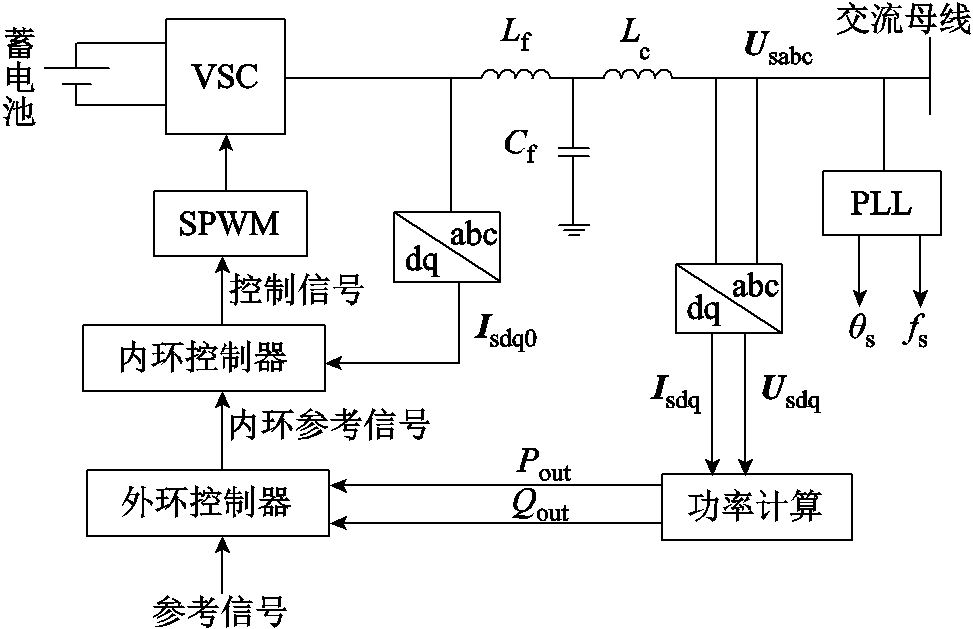
图1 电压源型逆变器控制系统典型结构
Fig.1 Typical structure of voltage source inverter control system
摘要 配置储能系统是解决新能源机组并网对电网产生冲击,保证系统安全可靠运行的有效手段。温度会对磷酸铁锂(LFP)电池的电性能产生显著的影响,从而影响储能参与电网调频过程中的实际充放电情况。该文重点分析温度对LFP电池荷电状态(SOC)的影响,首先展开温度对LFP电池实际容量、充放电效率等电池特性的影响机理研究,结合设备厂商给出的实际测试数据,提出基于环境温度的LFP电池模型参数修正方法;然后研究储能系统考虑校正SOC的时变下垂控制方法,提供快速频率支撑;最后在改进的IEEE 13节点微电网上验证了考虑环境因素后,能更准确地估计储能的SOC状态,提高了电力系统频率控制可靠性。
关键词:磷酸铁锂电池 荷电状态(SOC) 环境温度 充放电效率 频率控制
近年来,面对传统能源日益供需失衡、全球碳排放不断增加的严峻局势,世界各国都在不约而同地进行能源革命,以光伏、风电为代表的新能源正在迅猛发展[1-2]。然而,随着风力发电、光伏发电等新能源技术逐渐成熟并大规模应用,新能源在并网过程中表现出的随机性强、波动性大等特性给电网带来的影响越来越明显,这极大地限制了新能源的消纳能力,出现了严重的弃风弃光问题[3-4]。
大规模的储能技术是实现新能源普及应用的关键技术。由于风电、光伏等新能源发出的电力具有波动性,可调节性能差,配置储能装置能够有效调节电力供需侧的能量平衡,克服新能源出力的间歇性和不稳定性,提高电力设备的运行效率,保证系统安全可靠运行,是新能源系统的关键支撑技术[5-6]。目前国际上有超过20个国家在建或投产了超百余项涉及发输配用四大主要电力环节的MW级储能项目[7-8]。
磷酸铁锂(LiFePO4, LFP)电池因其优异的充放电性能、良好的安全性和循环寿命等特性,在含可再生能源的微网系统、电动汽车及通信基站等储能领域占有重要地位[9]。在磷酸铁锂电池应用领域都必须配备相应的电池管理系统。其中,电池荷电状态(State of Charge, SOC)的实时准确估算是电池管理系统工业应用过程中的重点和难点,也是科学合理利用电池能量的重要参数[10]。
然而我国地域范围极广,各地的气候也千差万别。在我国的西北和东北地区,由于夏季太阳照射时间长,冬季日照时间短,热岛效应明显,导致年温差与昼夜温差均很大。新疆乌鲁木齐极端高温47.8℃,极端低温-41.5℃,如此大的温度变化,会对锂离子电池的电性能产生显著的影响。温度是磷酸铁锂电池在应用中的重要影响因子[11-14],直接影响锂离子电池运行工况下的容量和材料活性,这是因为在电极/电解液界面上的电化学反应与环境温度有关[15]。电极/电解液的界面被视为锂电池的心脏。如果温度下降,那么电极的反应率也会下降:假设锂电池的电压保持恒定,放电电流降低,则锂电池的功率输出也会下降;如果温度上升则相反。即锂电池的输出功率会上升。温度也影响电解液的传送速度,温度上升时加快,温度下降时减慢,锂电池的充放电性能也会受到影响。但温度太高,会破坏锂电池内的化学平衡。对于锂电池来说,目前业内尚未有明确的理论支撑其各温度性能下的内阻、放电平台、寿命、容量等的必然联系,相关的计算公式和数学模型还在摸索阶段。
储能系统参与电网频率控制中的物理模型基于常规的模型数据,控制方案的生成基于不精确的仿真数据和模型,这些均导致控制策略的控制效果与实际电网的真实状态存在差异。传统机理模型分析和优化控制方法难以满足新型电力系统监测分析、运行优化和稳定控制的要求。
本文在储能参与电网频率控制时考虑环境温度因素,提出基于环境温度关联的模型参数实时校正方法,结合设备厂商给出的实际测试数据,提高电力系统建模过程模型参数的准确性。在此基础上储能系统参与电网调频控制过程中,采用基于实时校正SOC的下垂控制方法实现对实际电网调频工况的实时映射,提高频率控制效率。
为了更好地分析储能系统参与电网调控的方法,首先要构建能反映储能特性的物理模型。
电池储能是电池设备、功率转换系统(Power Convert System, PCS)和滤波环节所构成的整体。将储能装置接入微电网是通过逆变器实现的。应用较为广泛的逆变器的控制方式是双环控制器,外环控制器体现不同的控制目标,并产生内环参考信号,内环控制器用于精细的调节[16]。本文所采用的蓄电池电压型逆变器控制系统典型结构如图1所示。图中,Uabc为三相逆变器的交流网络侧电压,Cf和Lf分别为VSC滤波器电容与电感,Lc为耦合电感,fs和θs分别为所接交流母线处电压的频率和A相电压的相位,Usdq和Isdq分别为交流侧电压与电流经过Park变换后的dq轴分量,Pout和Qout分别为计算所得逆变器输出的瞬时功率,Isdq0为逆变器输入电流经Park变换后的dq轴分量。

图1 电压源型逆变器控制系统典型结构
Fig.1 Typical structure of voltage source inverter control system
执行功率计算块中的计算根据Park的dq轴理论,如图2所示。图中,Vd0、Vq0、Id0和Iq0分别为交流侧电压与电流经过Park变换后的dq轴分量,ωc为低通滤波器参数。

图2 功率计算模块
Fig.2 Power calculation modules
 (1)
(1)
为了得到相应的基本Pout和Qout分量,瞬时有功功率p和无功功率q通过低通滤波器进入外环控制器。外环控制器包含下垂控制和功率控制。储能逆变器通过控制dq轴电流分量快速响应外环的频率与电压偏差,调节储能系统的有功和无功的功率参考值,如图3所示。图中,Kf和Ku为下垂系数参数,KPp、KIp、KPq和KIq为功率控制PI控制参数,fs和Us分别为系统频率与交流母线电压幅值,f0、U0、P0和Q0分别为系统频率、交流测母线电压、有功功率、无功功率的基准值,Idref和Iqref分别为内环dq轴电流参考值。

图3 外环控制器控制原理
Fig.3 Control principle of outer loop controller
储能电池SOC是指在一定放电倍率下,电池剩余电量与额定电量之比。通常采用安时积分法进行估算,即通过电池充放电电流对时间的积分来计算电池充放电电量的变化[17],有
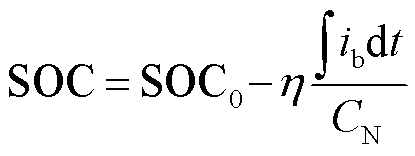 (2)
(2)
式中,SOC为电池的荷电状态;SOC0为电池的初始荷电水平;CN为电池的额定容量;ib为瞬时电流值;η为电池充放电效率。
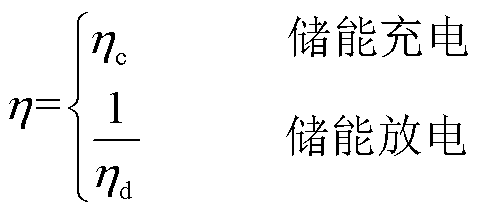 (3)
(3)
式中, 为充电效率;
为充电效率; 为放电效率。
为放电效率。
SOC作为表征电池剩余容量的一个状态量,其精确估算是电池管理系统中的核心技术之一,也是控制电池储能系统能量平衡的基础。SOC的准确估算不仅可以有效预防过充和过放,也是电池合理使用和有效维护的依据[18-19]。
基于储能电池的SOC状态,将储能电池的运行状态分为正常运行状态与警戒状态,如图4所示。当储能电池长期运行在低警戒与高警戒状态时会大大缩短电池的寿命。本文设定SOC处于正常状态时,可进行功率充放电,处于高警戒下仅能放电,处于低警戒下仅能充电,避免电池因过充、过放而影响电池寿命。

图4 电池运行状态
Fig.4 Battery operation status
电池的实际容量CN,T是重要的电池特性参数之一,而环境温度、电池的循环次数和电池平均放电电流是影响电池实际容量的三大主要影响因素。在锂电池中,工作温度对LFP容量的影响最为显著。
大量研究[20-21]表明LFP电池实际可用容量随环境温度的上升呈增加趋势。产生这种现象的主要原因是在电极/电解液界面上的电化学反应与环境温度有关,电极/电解液界面被视为锂电池的心脏。
当环境温度升高,电解液黏度下降、活性提高,电解液中离子的扩散能力增强,活性物质的利用率提高,实际电池容量增大。环境温度下降时相反,电池实际容量变小。但温度太高,会破坏电池内的化学平衡,导致副反应,从而影响电池充放电性能,电池材料的性能会退化,电池循环寿命也将大大缩短,这种损伤也是不可逆的。温度过高会使电池外包装鼓包破裂,电池中的化学物质与空气会产生爆炸。
磷酸铁锂电池的工作极限温度一般为-40~60℃,当温度低于0℃时电池的性能严重下降,活性严重降低,因此0℃以下属于低温阶段。当温度高于40℃时,电池的SOC可能会达到1.1,因此40℃以上属于高温阶段。锂电子一般性能完全的工作温度为0~40℃[22]。
充放电效率η是储能参与电网运行的重要参数,充放电效率即库仑效率。美国先进电池协会(United Stated Advanced Battery Consortium, USABC)规定库仑效率为电池放出的容量与充入到放电前容量的百分比。传统意义上的充放电效率没有考虑充放电倍率以及工作温度的影响。
文献[22]对100 A·h、软包装的LFP电池进行高、低温实验,实验结果表明:随着环境温度的升高,电池的充放电效率也得以提高;低温时电池的充放电容量和充放电效率下降显著;高温时电池的充放电容量和充放电效率有所增加,在锂电池的工作范围内,电池的充放电效率都在一个比较高的平台上。镍镉、镍氢、锂电池的放电效率在低温会有显著的降低(如低于-15℃),而在-20℃时,碱液达到起凝固点,电池充电速度也将大大降低。在低温充电低于0℃时会增大电池内压并可能使安全阀开启。
本文以CATL 280 A·h的LFP电池为研究对象,基于实际厂商测试结果数据,得到不同温度下电池的额定容量近似关系如式(4)所示。这样就能通过温度相关系数对电池额定容量进行修正。
 (4)
(4)
式中,Ct1为温度t1℃时的容量;Ct2为温度t2℃时的容量;α为容量随温度变化的温度相关系数,由实验测量得到,不同温度下的α不同。
表1为电池供应商宁德时代给出的CATL 280 A·h的LFP电芯在不同温度下的完整放电过程的能量效率,即电池在指定工况下完整放电过程中所释放的能量与电池额定充电能量之比值。额定充电能量即为电芯在额定工况(25℃恒温环境,气压101.3 kPa,RH≤85%),以1P功率从空电状态充电至3.65 V满电电压取得的充电能量。测试条件:充电工况——25℃, 1P CP to 3.65V;放电工况——25、45、5、0、-10、-20℃, 1P DP to 2.0V。由于实际应用的测试成本需要,工程中更倾向于监测具有代表性的温度点电池放电性能,因此温度颗粒度较大。基于实测数据,计算得到α如图5所示。
表1 CATL280A·h电池的完整充放电过程的能量效率
Tab.1 The energy efficiency of the complete charge-discharge process of the CATL280A·h battery

温度/℃能量效率(%)实际可用容量/(A·h) -2066.9187.32 -1078.8220.64 077.6217.28 582.7231.56 25100280 45101.4283.92
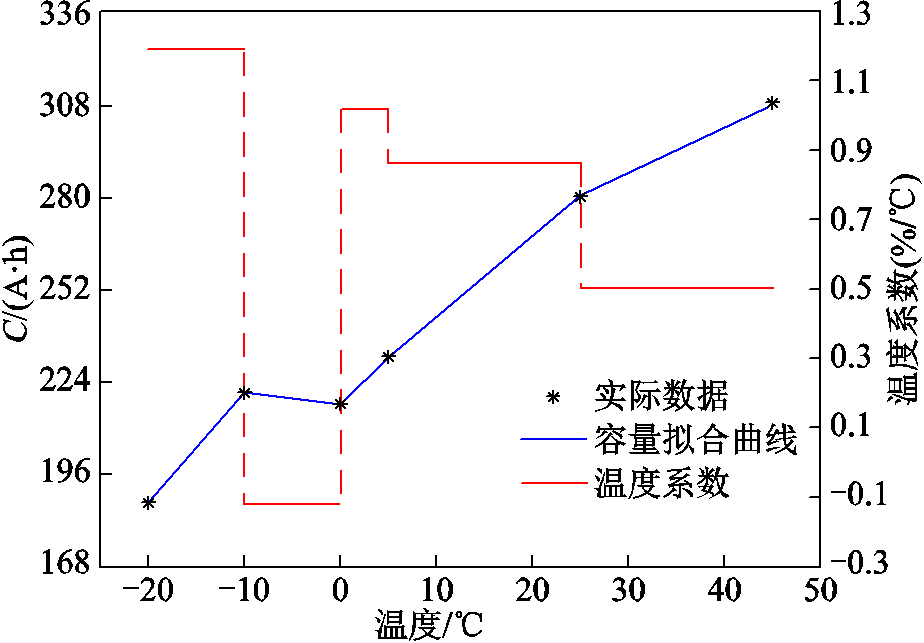
图5 LFP电池实际可用容量与温度系数随温度变化趋势
Fig.5 Trend of LFP cell actual available capacity and temperature coefficient with temperature
除了温度直接对额定容量产生影响外,电池的老化和电池自放电也会对电池额定容量产生影响:LFP电池有良好的电荷保护性,即其在长时间的静置条件下电荷丢失少、电池容量变化小;电池经过多次充放电循环后,电池容量降低,众多学者在额定容量估算中以循环次数为考虑项,在计算公式中添加了老化系数[23-25],但未单独列出温度对电池老化导致容量降低的影响参数。因此本文在SOC估算中未考虑电池自放电和老化系数。
由于大多数电池的内部都存在内阻,电池在充放电过程中均有较为明显的损失,因此储能系统必须考虑充放电的效率问题,即库仑效率。而温度也将影响电池的库仑效率,如式(5)所示。通过库仑系数可对充放电效率进行修正。
 (5)
(5)
式中,ηE为考虑温度后的等效充放电效率;KE为考虑温度的库仑相关系数;ηe为未考虑温度的等效充放电系数(以工作温度为25℃时电池充放电效率为基准效率)。基于厂商实测数据计算得到的KE如图6所示。
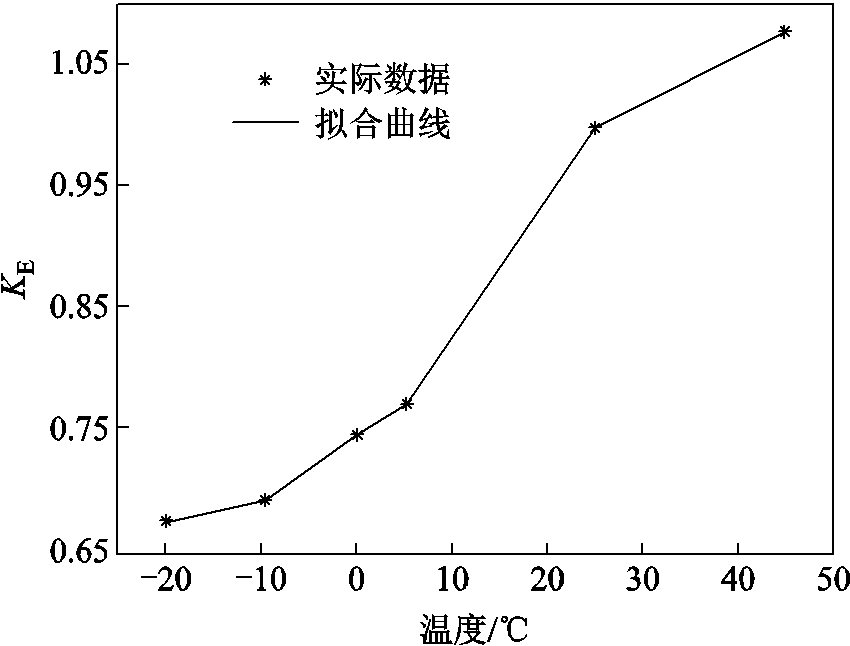
图6 LFP电池的库仑相关系数随温度变化曲线
Fig.6 Curves of Coulomb correlation coefficient with temperature for LFP batteries
本文考虑储能系统参与电网运行过程中,电压源逆变器控制的所有参数均不受环境温度等影响,仅考虑SOC受温度的影响。添加环境温度参数的电池SOC为
 (6)
(6)
实际运行过程中考虑环境因素的SOC将与未考虑SOC在极端环境下会有显著不同,这也将影响电池运行状态下的高警戒位置与低警戒位置的抵达时间不同,从而影响实际运行中电池的出力情况。
将储能系统应用于电网调频时,通常采用定下垂系数控制,但是这将可能出现过充过放的情形,因此须将SOC状态考虑到储能调频策略中[26]。本文考虑将基于实测温度修正后的SOC参数纳入频率控制中,提出一种基于实时校正的SOC的下垂控制方法,如图7所示。在储能系统参与电网调控阶段,时刻采集储能系统的温度,并对SOC状态继续持续校正。当系统发电功率突增,此时储能系统充电,如红色虚线所示。若SOC(T)<0.2时,此时储能可以以最大充电功率充电,减小系统不平衡功率。充电过程中随着SOC逐渐增多,下垂系数将以指数形式减少,此时仍持续参与频率调控,当SOC>0.8时,为保护储能过充导致寿命减少,此时停止充电。这样储能就能根据修正后的SOC状态实时修正储能充放电下垂系数。下垂系数如式(7)所示。

图7 基于SOC的储能下垂控制策略
Fig.7 SOC-based ESS droop control strategy
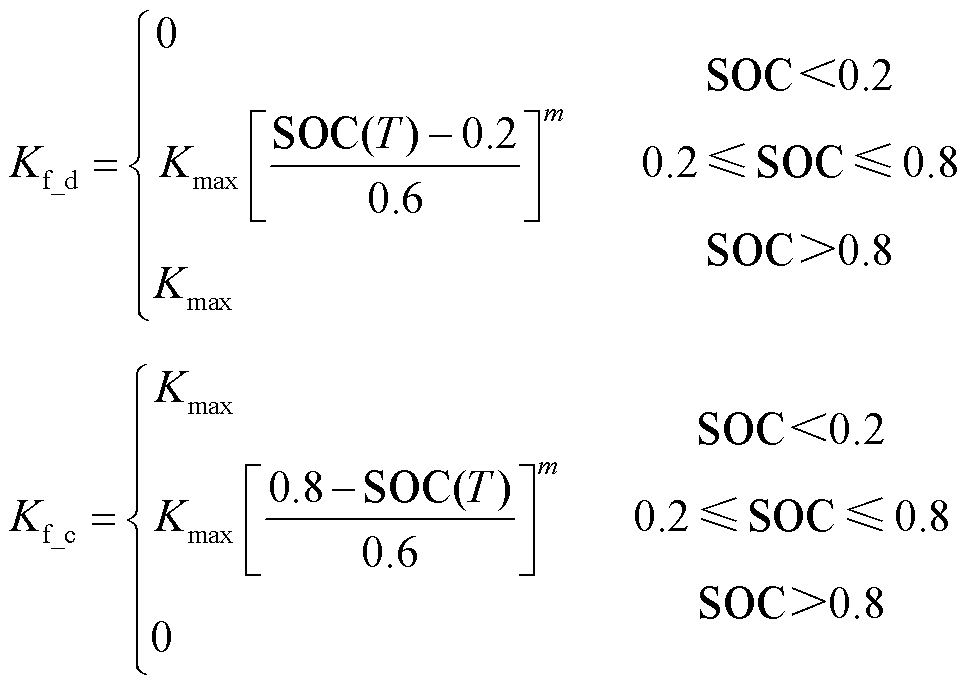 (7)
(7)
式中,m为指数变化速率;Kmax为最大下垂系数; 为放电下垂系数;
为放电下垂系数; 为充电下垂系数。
为充电下垂系数。
为了验证本文所提方法的有效性,将修正后的 IEEE 13节点系统[27]作为孤岛微电网,该电网由3.125 MV·A的柴油发电机(具有同步发电机、调速器和励磁机),装机容量为2 MW的光伏,1.5 MV·A的LFP储能系统(电池单体电芯为CATL 280 A·h)和负荷组成,如图8所示。通过在Simulink对该孤网系统进行仿真,以基于SOC的储能系统下垂控制参与电网调频过程来验证考虑环境因素对频率控制的有效性。
储能电池的初始状态设为0.5,未考虑环境因素下的充放电效率为0.9,最大充放电功率为50 kW。电池的控制参数见表2。本文设置三种温度场景:①内蒙某地区冬天温度为-10℃的极冷温度条件;②内蒙某地区夏天温度为45℃的极热温度条件;③内蒙某地区正常温度为25℃的标准温度。
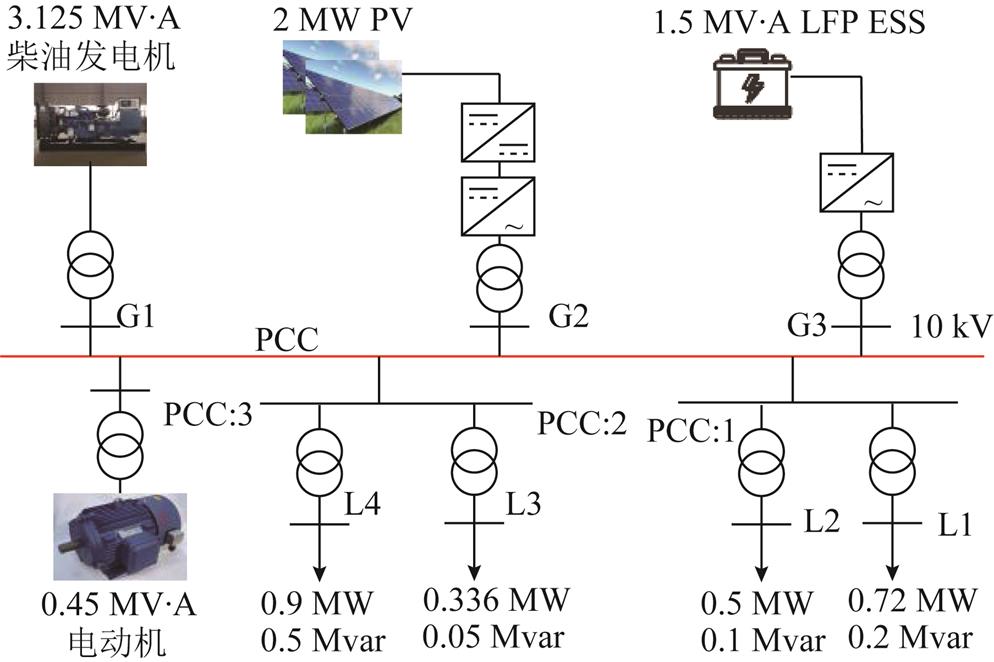
图8 修正后的IEEE 13节点孤岛微电网系统
Fig.8 Modified IEEE 13-bus islanded microgrid system
表2 电池控制参数
Tab. 2 Battery control parameters

参数数值参数数值 Lf/mH3KPp0.05 Lc/mH0.1KIp100 Cf/mF100KAq0.42 ωc/(rad/s)30KIq6 Kmax30m0.3
当电网负荷突增0.6 MW时,在该工况下柴油发电机的可调裕度不足,储能放电以参与系统频率控制。未考虑环境因素与考虑环境因素下的频率响应曲线与储能SOC变化曲线如图9所示。
由图9b可以看出,不考虑环境因素情况(T=25℃)下,在该场景下的1 000 s内储能的SOC始终处于正常区间,储能始终参与电网调控,且Kf_d由于SOC较高而处于较高位置,频率下降较慢,频率调节效果较好。
然而在实际工作中,高温(T=45℃)将导致SOC下降速度更快,并带着下垂系数Kf_d快速降低,频率调节效果降低,频率偏差增大。此外高温下,电池在855 s附近就进入低警戒状态(SOC=0.2),为了保证电池安全可靠运行,在本文的控制要求下,此时储能仅能充电,不能放电进行频率控制,即高温导致储能更快结束频率调控。此时系统调频资源仅剩柴发,频率将进入一个较低的稳态值,仍满足孤立电网频率偏差限制范围[28],如图9a所示。
低温(T=-10℃)场景下,SOC下降速度变缓,频率调节效果略高于常温工作环境(T=25℃),且将在更长的时间内进行放电,参与频率调节。

图9 阶跃扰动下不同测试条件下储能频率及SOC变化曲线
Fig.9 The frequency and SOC variation curve of ESS under different test conditions under step disturbance
为了验证本文所提方法对于连续的光伏波动下的有效性,本算例采用较为极端的光伏波动历史场景,如图10所示。储能系统参与电网调频具有快速响应的特性,能够配合柴油发电机平抑光伏功率的波动,如图11所示。

图10 极端光伏波动场景
Fig.10 Extreme PV fluctuation scenario

图11 连续扰动下不同测试条件下储能频率及SOC变化曲线
Fig.11 The frequency and SOC variation curve of ESS under different test conditions under continuous perturbation
不同温度环境下储能参与频率调节后的SOC变化曲线仍具有显著差异,如图11b所示。基于本文控制,下垂系数Kf_c受SOC影响,因此扰动前期三种环境温度的频率调节效果不完全相同。其中高温条件(T=45℃)下由于SOC略高于另外两种条件,下垂系数Kf_c将更小,因此频率调节效果更差,频率偏移量更大,如图11a所示。
此外,在光伏功率波动后期,高温(T=45℃)环境工况于1 738 s进入高警戒位置,之后储能系统只能放电,不能继续充电,从而退出频率控制。即高温促使储能尽快退出频率控制,随后该电网只能由柴发提供频率支撑。正常环境温度(T=25℃)下的储能系统将于2 118 s退出频率控制,低温(T=-10℃)环境在该2 750 s内均能参与频率控制。
基于以上分析,本文所提的考虑环境温度因素,并对SOC进行参数修正后的储能系统频率控制方法可以有效地针对极端天气情况,对电池的SOC进行更为准确的估计,使得频率控制效果更贴合实际运行场景,提高储能参与电网频率控制的效率与可靠性。
本文提出了考虑环境因素的储能系统频率控制方法,基于设备厂商给出的实际测试数据,对储能系统的模型参数SOC、额定容量,充放电效率进行了有效的实时校正。在此基础上提出的时变下垂控制方法将更贴合实际运行场景,减小储能参与电网控制策略的控制效果与实际电网的真实状态之间的差异。仿真结果表明,本文方法相较于不考虑环境温度因素而言,能更准确地估计储能的SOC状态,提高了电力系统频率控制效率。未来的研究方向包括耦合湿度、盐度等其他环境因素对储能设备参与电网调控的参数影响,进一步提高储能参与电网频率控制的模型参数的准确性。
参考文献
[1] 国家发展和改革委员会. 能源生产和消费革命战略[EB/OL](2016-2030). https://www.ndrc.gov.cn/fggz/ fzzlgh/gjjzxgh/201705/t20170517_1196767.html?code=&state=123,2017-05-17.
[2] 潘超, 范宫博, 王锦鹏, 等. 灵活性资源参与的电热综合能源系统低碳优化[J]. 电工技术学报, 2023, 38(6): 1633-1647.
Pan Chao, Fan Gongbo, Wang Jinpeng, et al. Low-carbon optimization of electric and heating integrated energy system with flexible resource participation[J]. Transactions of China Electrotechnical Society, 2023, 38(6): 1633-1647.
[3] 国家能源局. 2019年风电并网运行情况[EB/OL]. (2020-02-28)http://www.nea.gov.cn/2020-02/28/c_ 138827910.htm.
[4] 刘其辉, 逄思敏, 吴林林, 等. 大规模风电汇集系统电压不平衡机理、因素及影响规律[J]. 电工技术学报, 2022, 37(21): 5435-5450.
Liu Qihui, Pang Simin, Wu Linlin, et al. The mechanism, factors and influence rules of voltage imbalance in wind power integration areas[J]. Transactions of China Electrotechnical Society, 2022, 37(21): 5435-5450.
[5] Shi Zhaodi, Wang Weisheng, Huang Yuehui, et al. Simultaneous optimization of renewable energy and energy storage capacity with the hierarchical control[J]. CSEE Journal of Power and Energy Systems, 2020, 8(1): 95-104.
[6] Sioshansi R, Denholm P, Arteaga J, et al. Energy-storage modeling: state-of-the-art and future research directions[J]. IEEE Transactions on Power Systems, 2022, 37(2): 860-875.
[7] 孙冰莹, 杨水丽, 刘宗歧, 等. 国内外兆瓦级储能调频示范应用现状分析与启示[J]. 电力系统自动化, 2017, 41(11): 8-16, 38.
Sun Bingying, Yang Shuili, Liu Zongqi, et al. Analysis on present application of megawatt-scale energy storage in frequency regulation and its enlightenment[J]. Automation of Electric Power Systems, 2017, 41(11): 8-16, 38.
[8] 程瑜, 陈熙. 基于源-荷-储互动的储能对风电消纳能力影响分析[J]. 电力系统自动化, 2022, 46(13): 84-93.
Cheng Yu, Chen Xi. Analysis on influence of energy storage on accommodation capability of wind power based on source-load-storage interaction[J]. Automation of Electric Power Systems, 2022, 46(13): 84-93.
[9] Chang Minghui, Huang Hanpang, Chang Shuwei. A new state of charge estimation method for LiFePO4 battery packs used in robots[J]. Energies, 2013, 6(4): 2007-2030.
[10] Zhong Liang, Zhang Chenbin, He Yao, et al. A method for the estimation of the battery pack state of charge based on in-pack cells uniformity analysis[J]. Applied Energy, 2014, 113: 558-564.
[11] 李哲. 纯电动汽车磷酸铁锂电池性能研究[D]. 北京: 清华大学, 2011.
[12] 殷艳花, 窦银科, 左广宇, 等. 极地超低温环境下磷酸铁锂电池容量估计[J]. 电源技术, 2020, 44(5): 666-668.
Yin Yanhua, Dou Yinke, Zuo Guangyu, et al. Capacity estimation of lithium iron phosphate battery in polar ultra-low temperature environment[J]. Chinese Journal of Power Sources, 2020, 44(5): 666-668.
[13] 曹成荣. 考虑温度影响的磷酸铁锂电池建模及SOC估算研究[D]. 合肥: 合肥工业大学, 2017.
[14] 梅文昕, 段强领, 王青山, 等. 大型磷酸铁锂电池高温热失控模拟研究[J]. 储能科学与技术, 2021, 10(1): 202-209.
Mei Wenxin, Duan Qiangling, Wang Qingshan, et al. Thermal runaway simulation of large-scale lithium iron phosphate battery at elevated temperatures[J]. Energy Storage Science and Technology, 2021, 10(1): 202-209.
[15] Maleki H, Al Hallaj S, Selman J R, et al. Thermal properties of lithium-ion battery and components[J]. Journal of the Electrochemical Society, 1999, 146(3): 947-954.
[16] 王成山, 李琰, 彭克. 分布式电源并网逆变器典型控制方法综述[J]. 电力系统及其自动化学报, 2012, 24(2): 12-20.
Wang Chengshan, Li Yan, Peng Ke. Overview of typical control methods for grid-connected inverters of distributed generation[J]. Proceedings of the Chinese Society of Universities for Electric Power System and Its Automation, 2012, 24(2): 12-20.
[17] 李欣然, 户龙辉, 吕超贤, 等. 锂离子电池容量的预测建模及其仿真研究[J]. 系统仿真学报, 2014, 26(8): 1733-1740, 1746.
Li Xinran, Hu Longhui, Lü Chaoxian, et al. Research on lithium-ion battery capacity predictive modeling and its simulation[J]. Journal of System Simulation, 2014, 26(8): 1733-1740, 1746.
[18] 肖占龙, 郑岳久, 李相俊, 等. 变温下磷酸铁锂电池的SOC估计方法研究[J]. 电源学报,2023:1-13[2023-02-17].
Xiao Zhanlong, Zheng Yuejiu, Li Xiangjun, et al. Study of SOC estimation method of LiFePO4 battery uder variable temperature [J]. Journal of Power Supply, 2023: 1-13 [2023-02-17].
[19] 吴立峰, 刘昊, 林仲钦, 等. 低温环境下锂离子电池荷电状态与超声透射飞行时间的关系研究[J]. 电工技术学报, 2022, 37(21): 5617-5626.
Wu Lifeng, Liu Hao, Lin Zhongqin, et al. Relationship between state of charge of lithium-ion battery and ultrasonic transmission flight time at low temperature[J]. Transactions of China Electrotechnical Society, 2022, 37(21): 5617-5626.
[20] Lee E S, Huq A, Manthiram A. Understanding the effect of synthesis temperature on the structural and electrochemical characteristics of layered-spinel composite cathodes for lithium-ion batteries[J]. Journal of Power Sources, 2013, 240: 193-203.
[21] Cho H M, Choi W S, Go J Y, et al. A study on time-dependent low temperature power performance of a lithium-ion battery[J]. Journal of Power Sources, 2012, 198: 273-280.
[22] 罗玲, 宋文吉, 林仕立, 等. 工作温度对磷酸铁锂电池SOC影响及研究进展[J]. 新能源进展, 2015, 3(1): 59-69.
Luo Ling, Song Wenji, Lin Shili, et al. Research progress on effects of temperature on SOC and its estimation for LFP battery[J]. Advances in New and Renewable Energy, 2015, 3(1): 59-69.
[23] 张彩萍, 张承宁, 李军求. 电传动装甲车辆用锂离子电池充放电特性[J]. 电源技术, 2010, 34(2): 109-112.
Zhang Caiping, Zhang Chengning, Li Junqiu. Charge and discharge characteristics of lithium-ion traction battery for electrical drive armored vehicles[J]. Chinese Journal of Power Sources, 2010, 34(2): 109-112.
[24] 张祺. 用于动力电池整包快速检测的容量估算方法研究[D]. 北京: 北京交通大学, 2020.
[25] 孙丙香, 任鹏博, 陈育哲, 等. 锂离子电池在不同区间下的衰退影响因素分析及任意区间的老化趋势预测[J]. 电工技术学报, 2021, 36(3): 666-674.
Sun Bingxiang, Ren Pengbo, Chen Yuzhe, et al. Analysis of influencing factors of degradation under different interval stress and prediction of aging trend in any interval for lithium-ion battery[J]. Transactions of China Electrotechnical Society, 2021, 36(3): 666-674.
[26] Yu Jie, Liao Siyang, Xu Jian. Frequency control strategy for coordinated energy storage system and flexible load in isolated power system[J]. Energy Reports, 2022, 8: 966-979.
[27] Acharya S, El Moursi M S, Al-Hinai A. Coordinated frequency control strategy for an islanded microgrid with demand side management capability[J]. IEEE Transactions on Energy Conversion, 2018, 33(2): 639-651.
[28] 国家质量监督检验检疫总局, 中国国家标准化管理委员会. GB/T 15945—2008 电能质量电力系统频率偏差[S]. 北京: 中国标准出版社, 2008.
Abstract Lithium iron phosphate (LFP) batteries occupy an important position in the field of energy storage system (ESS) because of their excellent charge and discharge performance, better safety and cycle life. Temperature is an important factor in the application of LFP, affecting the capacity and material activity of LFP under operating conditions. The physical model of ESS involved in system frequency control is often based on conventional model data. However, the traditional mechanism model analysis and optimal control methods are difficult to meet the requirements of actual system. Therefore, this paper proposes a real-time correction method of model parameters based on environmental temperature correlation when ESS is involved in system frequency control, which can estimate the SOC of ESS more accurately and improve the reliability of frequency control.
Firstly, the mechanism analysis of temperature on the performance parameters of LFP is developed, focusing on the reasons for the impact of high and low temperature on the actual capacity and charging/discharging efficiency of the battery. Secondly, based on the actual test data provided by the manufacturer, the temperature coefficient and coulomb correlation coefficient are used to correct the actual capacity and efficiency, followed by real-time correction of the SOC in battery operation. Subsequently, the time-varying droop control method of the ESS considering the corrected SOC is studied to provide fast frequency support. The SOC considering environmental factors during actual operation will be different from the SOC without considering the extreme temperature, which will also affect the arrival time of the high and low alert positions in the operation state, thus affecting the battery discharge. By making real-time corrections to the SOC, the accuracy of ESS participation in system frequency regulation can be improved.
The improved IEEE13 node simulation results show that: under the step disturbance of the system by the sudden change of load, the SOC of ESS is always in the normal range within 1 000 s without considering the environment (T=25℃), the ESS always participates in system regulation, and the droop coefficient Kf_d is in a higher position due to the higher SOC, the frequency drops slowly, and the frequency regulation is better. However, high temperature (T=45℃) will lead to faster SOC decline and carry Kf_d to decrease rapidly, and the frequency regulation effect is reduced. In addition, the battery enters the low alert state near 855s, when the ESS cannot discharge for frequency control, that is, high temperature leads to the ESS to end regulation faster. Low temperature scenario (T =-10 ℃), discharge rate becomes slower, the frequency regulation effect is slightly higher than the normal temperature, and will be discharged for a longer time to participate in frequency regulation; the system is subject to extreme fluctuations in PV, the ESS has a fast response characteristics, can cooperate with the diesel to smooth out the fluctuations in PV power. The frequency regulation effect of the three ambient temperatures in the pre-disturbance period is not exactly the same, where the high temperature condition will have a smaller Kf_cdue to a slightly higher SOC than the other two conditions, so the frequency regulation effect is worse and the frequency offset is larger. Besides, in the late stage of PV power fluctuation, the high temperature condition enters the high alert position at 1 738s, after which the ESS cannot continue charging thus exiting the frequency control. That is, high temperature prompted the ESS to withdraw from frequency control as soon as possible, and subsequently the system can only be supported by the diesel. The ESS under normal temperature will exit at 2 118 s, and the low temperature can all participate in frequency control within that 2750 s.
From the simulation analysis, the frequency control method of the ESS proposed can effectively estimate the SOC more accurately for extreme weather conditions after considering the environmental temperature factor and making the frequency control effect more suitable for the actual operation scenario, and improve the efficiency and reliability of ESS participation in system frequency control. The method in this paper can estimate the SOC of ESS more accurately and improve the efficiency of frequency control compared to that without considering the environmental temperature factor.
keywords:LiFeO4 battery, state of charge (SOC), ambient temperature, charge/discharge efficiency, frequency control
中图分类号:TM732
DOI:10.19595/j.cnki.1000-6753.tces.L10018
国家重点研发计划资助项目(2020YFB0905904)。
收稿日期 2023-01-13
改稿日期 2023-03-07
余 杰 女,1997年生,硕士研究生,研究方向为电力系统运行与控制。E-mail:yuujie@whu.edu.cn
廖思阳 男,1989年生,副教授,博士,研究方向为新型电力系统运行与控制、工业负荷调控。E-mail:liaosiyang@whu.edu.cn(通信作者)
(编辑 赫蕾)